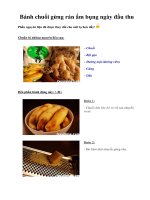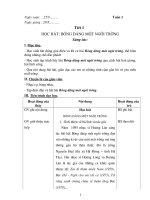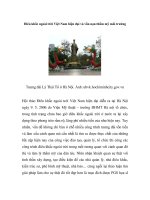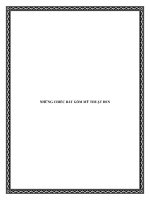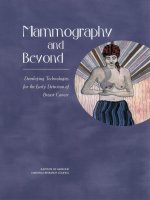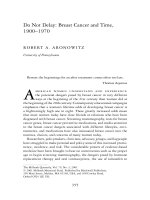I AM NOT MY BREAST CANCER ppt
Bạn đang xem bản rút gọn của tài liệu. Xem và tải ngay bản đầy đủ của tài liệu tại đây (1.67 MB, 401 trang )
I AM
MY BREAST CANCER
Women Talk Openly About Love & Sex,
Hair Loss & Weight Gain,
Mothers & Daughters,
and Being a Woman with Breast Cancer
Ruth Peltason
FOREWORD BY Peter I. Pressman, M.D., F.A.S.C.
For my grandparents,
Ruth M. and Paul E. Peltason
I see dark nights and beautiful sunny days.
I see the seasons changing with a feeling of hope.
I am a hawk, soaring over the world and brushing
those I love with the wind from my wings.
I see myself committed to making the world a
better place, striving to help those in need
of healing and succor. I see hurt and anger
sometimes, but mostly cheer and good humor.
I see life. I see myself, forever and always.
—Gwendolen R. Leighty (“songbird”),
1955–2005
Contents
Epigraph iv
Fore word by Peter I. Pressman, M.D., F.A.S.C.
viii
Introduction by Ruth Peltason
x
part one DIAGNOSIS
ONE Sharing the News 3
TWO Crowning Glor y: Hair Today, Gone Tomor row 28
THREE Feelings: A Kitchen Sink of Emotion 44
FOUR Fear 80
FIVE Work 90
part two LIVING WITH BREAST CANCER
SIX Being Womanly 109
SEVEN Love Relationships and Sexual Intimacy 147
EIGHT Basic Relationships, A to Z 197
NINE Mothers and Daughters 222
TEN Children 237
part three THE BIG PICTURE
ELEVEN Anniversaries and Milestones 271
TWELVE Mortality
THIRTEEN W hen You Look in the Mir ror, W hat Do
280
You See? 302
FOURTEEN Faith, Religion, and Spirituality 340
FIFTEEN Gathering Rosebuds 351
Afterword by Marc N. Weiss 365
List of Breast Cancer Organizations 371
Acknowledgments 373
About the Author
Credits
Cover
Copyright
About the Publisher
Foreword
I Am Not My Breast Cancer is a book that will help women realize that they
are not alone when dealing with this disease. It will help their families,
friends, colleagues, and also their physicians—anyone who is part of the
fabric of their lives. It is a book that addresses what women are really feel
-
ing during this time when their health is at risk and their emotions are
running high. It touches on the feelings they have about themselves
head-on, with no compromises and no punches pulled.
I suspect that anyone who reads this book will be somewhere
along the road of discovery, treatment, or recovery from breast can-
cer. It addresses the reactions a woman with breast cancer will have
at these different stages as well as the responses of those around her. It
is not designed as a repository of medical facts. I have written books
for women about breast cancer and believe these professional guides
are important. But even the most responsive and compassionate phy-
sician—male or female—cannot provide the enormous range of per
-
sonal support women can provide to one another.
If you are lucky enough to have a friend who has been through
treatment at your side, that can be a terrific asset. That’s rare, how-
ever. Some women find it useful to attend support groups. But for
others, the spectrum of personalities among women and the unpre
-
dictability of the weekly agenda may be daunting and not helpful.
The session you attend may be focused on the subtleties of breast re-
construction when you may be concerned about imminent hair loss or
how to tell your teenage daughter what’s happened. How do you find
the group that is right for you?
ix Foreword
The Internet is another source of information, and the stories of
other women’s lives can be at your fingertips. But this takes time at
the keyboard and a lot of searching—no matter how computer savvy
you are, you might end up in the wrong chat room or not be able to
find what you need. This book recognizes the value of the Internet as
a resource and is based on the author’s Web project named First Person
Plural. Ruth Peltason, who has had breast cancer, has read the stories
of hundreds of women who took part in that project. Her achievement
in I Am Not My Breast Cancer is to have woven these voices into a com
-
pelling narrative that speaks boldly to what women feel during this
time. Her book is organized so that you can easily read the contents
and focus on the experiences other women have had in very specific
areas that may be your current concern.
No one person can tell you how to react, behave, and manage per-
sonal or medical encounters. Everyone has a specific style. We read
novels because authors have the ability to enlighten us with insights into
other peoples’ lives. Here, Ruth Peltason provides an ongoing, cohesive
narrative, making it much more than a collection of questions and an
-
swers. The book is a sharing of emotions combined with a lot of medi-
cal facts, too. There is the reality of the side effects of medical treatment,
as well as how the diagnosis and treatment of cancer are handled dif
-
ferently by family, friends, and coworkers—and also how others may
react to you. You can read it from cover to cover, or you can concen
-
trate on the topics that are most beneficial to you. In either case, the
book will be there for you according to your needs.
Some people say the experience of having cancer transformed
them; it certainly does change your life, at least for a while. During
that time, it is useful to have a book close by that, while it will not
have your name in the index, has a table of contents that ref lects your
journey. It is also comforting to take solace from and to learn from
the experiences of others.
Peter I. Pressman, M.D. F.A.C.S.
Introduction
B
y the time I was in the fourth grade, I had a stack of dreams:
I wanted to be a teacher, baton twirler, model, writer, artist,
and have a springer spaniel farm. None of these dreams in-
cluded being someone with breast cancer.
Fast forward to when I was thirty-five, going for my first mam-
mogram. To be honest, I didn’t even know what getting a mammo-
gram actually involved, so when I was told to raise my arm, lean
forward, and not breathe while my breast was sandwiched between
a cold, viselike thing (what I now call the “mammogrammer”), I
thought it was pretty weird and barbaric. It was also painful. And
when I was told that more images were needed, it didn’t occur to me
that this was unusual; I didn’t even bother to ask why. Looking back,
the period between those last images and when the radiologist, Julie
Mitnick, walked in and spoke to me marked the shift from innocence
to loss. In real time it was only a few minutes, but for me it was an
eternal gauntlet thrown down: You have cancer. You might die. To
-
day your life will change.
Breast cancer is one of the most democratic diseases. Regardless
of a woman’s education or bank account, where she lives, whether
she’s pretty or nice or highly moral, today one in eight women is diag
-
nosed with breast cancer; 85 percent of them have no family history
of the disease. Indeed, in women the only cause of death greater than
breast cancer is lung cancer. When I consider my breast cancer along-
side these facts, I’m just a blip on the screen, a number among other
numbers. When I was thirty-five, I recall, one in nine women would
xi Introduction
get breast cancer. At the time I had about eight to ten close girlfriends,
so I figured that if I was taking a bullet for the group, it wasn’t so bad.
My lumpectomy sure wasn’t a mastectomy, and having radiation was
in no way like chemo, so it was a piece of cake, a morceau de gâteau that
I could handle. I was never mad, I never felt that God was punishing
me or that bad karma or kryptonite was raining down on me. I was
not, I told myself, Chicken Little or Pigpen, and I was not going to say
the glass was half-empty when it still looked half-full.
Over the next dozen years I had additional biopsies, not pleasant,
but not overly worrisome, either. But then my luck changed, or the
cancer recurred, or something, because in my late forties Julie Mitnick
again said, “I have some bad news for you.” And this time I was out
of wiggle room: a mastectomy, reconstruction, and chemotherapy fol
-
lowed. So did hair loss, dry skin, and aching joints. And a tremendous
sense of loss and worry. I was also bewildered. When my brother Jim
asked if I felt like “why me,” I replied, “No, but I wonder, ‘Who—me?’ ”
Surely they had the wrong girl. I was the little drum majorette, the
high school track star, the overachiever, the girl who got the boys.
Wrong. Now I was the girl who got breast cancer, and I didn’t like it
one single bit. I didn’t feel like I’d survived anything, I just felt shitty
and alone.
That’s when the idea for this book kicked in. I’d been home from
the hospital for a few days and my sister-in-law, Barb, was staying
with me to help out. It was about two a.m., she was asleep in the next
room, and I was trying to get out of bed. Tr ying because part of my
abdominal muscles had been cut during the tram flap procedure, so I
didn’t have the strength to go from a prone position to one sitting up,
and so I was stuck, with my legs hanging off the side of the bed. I was
just sort of rocking, like a turtle on its back, and in pain. “This is ri
-
diculous,” I thought, “I can’t even get out of bed by myself.” Yet in-
stead of having my own little pity party in the dark, I realized that if
I was having a hard time, even with a great support system of family
and friends, and some of the country’s best doctors, what about
Introduction xii
women whose lives were harder? What about women who had chil-
dren to get dressed and off to school in the morning? Or what about
women who lived miles away from their doctors and a good hospital?
Or women whose husbands or partners weren’t supportive? Or had
employers who weren’t sympathetic? Worse still, what about women
who were f lat-out alone? I knew I wanted to do something, and I re
-
solved to write a book that would speak to all of us. I would write the
book I couldn’t find, for women I didn’t know but who, like me, were
struggling with life issues.
I’m a nut for books, and one overall addiction I claim is an ap-
petite for too many interests, hence too many books. Yet, weirdly, I
only owned two books about breast cancer, both of them medical
guides—one by my surgeon, Peter I. Pressman, and one by Dr. Susan
Love. To me, the other breast cancer books seemed too saccharine or
superficial, a little too “la-di-da,” as Annie Hall would say. I wanted
the warts-and-all, tell-all sort of book that focused on how women
with breast cancer dealt with undressing—with a lover or in a locker
room at the gym; what it was like losing your hair (and not just on
your head) and having it come back in; whether women gave up ca
-
reers or pursued them harder; whether humor helps and worrying
about mortality hinders. Was there any proverbial silver lining in the
breast cancer cloud or was it just rain, rain, rain? Was anyone else
afraid to buy green bananas?
While I was going through chemo, friends often came by to help
out or to provide good cheer. One evening Marc Weiss, the husband
of one of my best friends, came by. (Marc’s wife, Nancy Meyer, and I
grew up in St. Louis, and in New York we live only a few blocks from
each other.) I was telling Marc that there was no book that really
spoke to me about the so-called big issues of living with breast can-
cer—and certainly not to the degree that I craved. Marc has a well-
regarded Web company that produces online dialogues about
important social issues, and after a little brainstorming we hatched a
plan to work together and combine our skills. From the start, it would
xiii Introduction
be a two-part project: Marc and I would develop a website, and I in
turn would adapt it for the book that I felt was needed. We decided
that only women with breast cancer could participate—no siblings or
parents; no husbands, partners, or friends; no doctors or therapists.
Simply stated, this was a “members only” club. The Web project,
named First Person Plural and formed with the help of ten leading
breast cancer organizations, advisers, and funds from many generous
souls, was launched two years later. Wobbly, perhaps. Idealistic—
most certainly.
After we hosted the Web project I began reading the comments,
sorting through the material, and making the selections for this book.
What you are holding is easily one-fifth of the rich bounty I had to
consider. Ultimately, I must have read thousands of stories told by
eight hundred women. This extraordinary number of women—by
far the largest to date in any book on the subject of living with breast
cancer—comes from every state in the country, as well as from Can
-
ada, Europe, Australia, and Africa. Racially, they are white, African-
American, Hispanic, African, and Asian. They range in age from
their early 20s to their late 70s. Some of them are dealing with pre-
cancers, whereas others are dealing with metastases or are terminally
ill and coping with all that entails. Yet they all benefit from connect
-
ing with women who have breast cancer. Although their communica-
tions were frank and intimate, they used pen names (“screen” names
in computer lingo) to preserve their real identities. They signed their
notes with these names and used them when addressing one another.
After a while, writing to “Blue Girl” seemed as natural as using
“Anne” or “Lucy,” and so this form of identification is carried for
-
ward in this book. Significantly, I think this privacy permitted the
women to reveal some of their deepest feelings (the warts-and-all ele-
ment), especially when talking about their families or sexuality or, say,
aspects of their childhood. What you read here are the original texts,
with a little spit-polish—in editing the women’s comments, I did my
best to preserve individual cadence and voice, limiting myself to cor
-
Introduction xiv
rections of spelling and grammar, typos, and tightening of passages
for impact and considerations of length.
For the most part, I felt that the comments succeeded without
further annotation (and distraction) from me to the reader, although
the chapters “Children” and “When You Look in the Mirror, What
Do You See?” are exceptions to the rule. Here I added brief bio
-
graphical information because I felt that age or family history, to cite
two such examples, was especially relevant to some of the entries.
I Am Not My Breast Cancer is authored by ordinary women with
breast cancer for readers everywhere who are dealing with breast
cancer and its many personal and symbolic ramifications. The women
included here work in factories, are stay-at-home moms, secretaries
and CEOs, teachers and nurses. They are blue collar and white col
-
lar; atheists and believers; straight and gay; single, married, divorced,
and widowed. Some work two or three jobs; others are newly retired.
Women who have traveled the world swap stories with those who
have never left the small towns where they were born and raised.
Language and writing skills vary. I applaud the similarities and the
differences, for these are the real voices of women everywhere doing
their honest best to communicate, share, and learn. They support one
another, they grieve together, and they have what they call “group
hugs.” (One woman, who lives in a remote community in the north
-
west, wrote that for the first time she didn’t feel alone. It was also the
first time in ten years that she’d ever talked about having breast can
-
cer.) I am immensely proud to introduce readers to my eight hundred
new friends. Sadly, in the course of assembling this book, some of the
women who participated in the online project and whose comments
are here have since died. They are cherished and deeply missed.
As everyone who’s been diagnosed with this disease knows, some-
times the only constant or enduring help is from other women like
us. Nothing is more isolating than finding out that you have breast
cancer, and the sympathy we get from friends or family only goes so
far—typically it’s intermittent and often freighted with other issues.
xv Introduction
Even the status of loved ones as “outsiders” never changes. Women
with breast cancer thrive on connecting with other women who speak
the same language and share the same concerns. The help and nur
-
turing they offer one another is its own reward.
I Am Not My Breast Cancer has been organized in three parts,
which loosely chronicle the progression of living with breast cancer.
Part 1, “Diagnosis,” begins with receiving and sharing the news of a
diagnosis, and includes the many feelings one experiences (anger, de
-
pression, stress, coping, et cetera), hair loss, and being at work. Part 2,
“Living with Breast Cancer,” focuses on primary relationships for
women: with their spouses and lovers; as mothers and daughters; and
with family, friends, coworkers, in-laws, even pets—which one woman
aptly called her “fur babies.” The material here about sexual inti
-
macy is remarkable for its candor and depth: no one pussyfoots around
delicate topics, although more than one woman remarked she was
glad the comments were anonymous (ditto for her husband!). If you’ve
ever wondered how someone else felt when making love following a
mastectomy, or how other women dealt with a spouse who seemed to
shut down, or about other young women struggling to have children
after chemotherapy, you will find it here. The last section of the book,
“The Big Picture,” addresses the significance of anniversaries and
milestones; the role of religion and spirituality; and mortality. For me,
the chapter “When You Look in the Mirror, What Do You See?” is
the most moving: more than two thirds of the women responded to
this call for a frank assessment of themselves. Their written self-por-
traits are full of heart and honesty. Imagine the courage it takes for a
woman diagnosed at the age of thirty-four and put into chemical
menopause to write, “When I look in the mirror I see a future.” And
imagine the humanity expressed here: “When I look in the mirror I
see every other woman who has gone through this.”
The overall optimism expressed by the women in these pages is
one of the unexpected revelations I had while working on this project.
Woman whose lives were hard as dirt distinguished themselves with
Introduction xvi
dignity and grace; women who’d had to terminate a pregnancy man-
aged to smile through their tears; and women who had previously lost
a sister or a mother or an aunt to breast cancer remained defiantly
positive. I’m no scientist, but I’m tempted to say that women naturally
have an inner buoyancy and resiliency.
On a more political front, these voices are a wake-up call: we
need to overhaul the mind-numbing and dehumanizing health insur
-
ance for women in this country. Not one woman in this book was
satisfied with her health insurance—and that’s a shameful statistic.
Having a diagnosis of breast cancer is hard enough; actually having
to persuade some anonymous health insurance clerk to approve what
the companies have decided are out-of-network services—mammo-
tome biopsies, surgery for tram f laps, nipple reconstruction, or breast
symmetry, for example—is humiliating. And exhausting. Should a
woman really have to fight for a surgery that allows her the dignity of
having her post-operative breasts look the same size? Should a woman
have to forfeit some household item so she can pay for much-needed
care by a psychotherapist to alleviate anxiety or depression? For some
women, this struggle becomes the factor that finally breaks their
spirit. This is wrong. I believe we can and should do better.
My greatest wish for this book is that it offer comfort to any
woman living with breast cancer and to those who care about her. If
this book is kept on the bedside table, then I hope its need is brief and
its impact lasting. I Am Not My Breast Cancer speaks of courage, hero
-
ism in deeds small and large, and incredible faith and fortitude. Even
the title of this book underscores an unwillingness to be defined by
disease. As Alexander Pope, the great eighteenth-century English
poet, wrote, “Hope springs eternal in the human breast.” How true,
and how nobly this is displayed in the hundreds of comments included
here, for in books no voice is ever hushed and dreams never end.
Ruth Peltason
New York, New York
PART ONE
Diagnosis
CHAPTER ONE
Sharing the News
“How do you tell your family news you can
barely comprehend yourself?”
lovinglife
T
here was nothing laudable about how I learned that I had
breast cancer: the surgeon who performed the biopsy literally
said, “I’m so surprised. You have a malignancy,” as I was
walking into his office and before I’d even closed the door. Welcome to
my world. I had just turned thirty-five. (Ironically, I had been hum
-
ming an old Streisand tune “Happy Days Are Here Again” on my way
to the doctor’s office—indeed!) In the couple of seconds it took this
doctor to speak, my life was forever changed. That was also the last
time I ever heard an ill-spoken word from a doctor and marked the
first time I took my care into my own hands—I changed surgeons and
have been happy ever since. But back to that day: after the appoint
-
ment I went to my office and called one of my best friends. Without
skipping a beat, she came immediately—we cried, and then I left the
office without saying a word and took off the rest of the afternoon. I
remember we went out for lunch.
To this day, however, I still can’t recall the specifics of calling my
parents in St. Louis to tell them I had breast cancer. For one thing, I
4 I AM NOT MY BREAST CANCER
remembered that my mother’s brother died at the age of fifty-four from
bone cancer and that my grandparents felt a lifelong sadness because of
that. Was I going to die before my parents, too? Weren’t children sup
-
posed to outlive their parents? My father’s response was simple and
direct: “Come home” and be treated there; I was already very uncom
-
fortable having the discussion, but I stood my ground, saying that I
felt the best doctors were in New York. What else? I’m sure they asked
questions; I’m sure I tried to answer those I could.
Jump ahead twelve years. I had a recurrence and this time the
stakes were higher. And by this time my father had passed away.
Again, I called that same best friend. Maybe she called my mother;
maybe I called my brothers. Maybe some variation on this occurred. It
was not a happy time, and I was weirdly calm, in that calm-before-
the-storm sort of way. As for my friends and colleagues: I think the
news trickled out, on a need-to-know basis. Memory, as I have learned,
can be an unreliable witness.
Sharing this kind of news is an active process fraught with emo-
tion. As a sign of modern technolog y, often the most efficient (and
least stressful) way to communicate is by e-mail, typically with the
so-called calmest family member designated as “sender.” Understand
-
ably, the following accounts detail highly charged experiences. And
while the conditions are similar—the women have just learned they
have breast cancer—their stories are unique.
FAMILY
I just wished my mom wasn’t by herself when she was told. She lost
her husband of 48 years to cancer and then me getting it was like a
nightmare. I can only imagine what she is feeling, but I know how
horrible it would feel if one of my children were diagnosed with any
kind of cancer. My youngest daughter came to see me later that
evening and as soon as I saw her I started to cry and told her I have
never even f lown a kite so I was going to fight this with all I could.
Sharing the News 5
She assumed the role of mother and was there during my emotional
outbursts and helped me to gain my composure.
lilybelle2
My mother-in-law cried every time I talked to her. That was very upset-
ting for me. I felt I had to comfort her instead of the other way around.
ritavv
I had to tell my parents over the phone as they were on vacation and
that was so hard. It makes you cry twice, because you have to all cry
again when you see each other.
Michele
My husband was a seven-hour drive away on maneuvers with his Air
National Guard unit. I got him on his cell phone and told him that I
might have cancer and to stand pat. I might need to have the Red
Cross bring him home. (My wonderful husband was by my side a day
later.) My parents were local. They were out of the house and on the
way to the doctor’s office within 5 minutes and we all waited for me to
go in to have the ultrasound.
I so didn’t want to scare them, but I was scared and needed my
mommy and daddy there. When the results of the ultrasound showed
positive for cancer, we had a group hug and they held me as I cried.
Then I held my mom as she cried—her mom had died of breast can
-
cer and she always taught me to be vigilant in preventive measures.
My eyes met my dad’s and I became resolute that I would beat this.
He’d been through too many tragedies in his life—he lost his whole
family in the gas chambers of Treblinka. I would not have him lose a
child. That was simply not an option.
CarynRose
Since my sister had died from breast cancer in 1986 at age 43, my
husband had been secretly waiting for “the other shoe to drop.” My
6 I AM NOT MY BREAST CANCER
husband, who is very protective of me and has been my soul mate
for the last 33 years, assumed the job of the “teller.” He broke the
news to our sons, which was so difficult for him. My close girl
-
friends, who are like family to me, took the news so very hard. They
were with me through my sister’s horrific illness and they saw what
it did to me. They were not sure I was strong enough mentally to
make it through the same horrendous treatment again. But, I guess
I found out that I’m stronger than anybody thought I was. Now, 5
1
⁄2
years later, my doctors tell me that I am well and healthy. I am truly
a lucky girl.
Swanky Sue
When I called my sister, who isn’t the brightest tool in the shed, God
bless her, she asked me immediately, “Are you going to die?”
Marybe
When I was diagnosed after my biopsy I didn’t want to tell my family
until after I had my next surgery so I would have a better idea of what
to tell them. The night after I got home my sister called me and said
“Oh, I just had to call you. I had the strangest dream, I dreamed I was
fighting with our brother Sean because he said he was going to take
you away from us!” You see, my brother died of AIDS in 1993. Well,
at that point I told her and we cried together. I then decided to tell my
other brother who was working on a cruise ship in Alaska. When I
called him he said, “I had a weird feeling something was wrong. I was
standing on the dock and something on a park bench kept flashing in
my eyes; when I looked to see what it was, it was the same saying that
we had put on our brother’s headstone painted in gold.” I believe that
my brother Sean was helping me to contact everybody. When he was
alive he would nag me about calling everyone to stay in touch. The
saying was from an Alice in Wonderland poem that he liked: “Lingering
in the golden gleam/Life, what is it but a dream?”
B-Positive
Sharing the News 7
I have 2 sisters, 9
1
⁄2 and 11
1
⁄2 years older than I. Our mother was di-
agnosed with breast cancer in 1977, my oldest sister in 1997, and I in
2000. My oldest sister was away from home that weekend, and my
mom “unreachable” because of her Alzheimer’s. After telling my
brother/boss, I called my other sister to tell her my news. She didn’t
say anything for a while, then very quietly said, “It’s supposed to be
my turn.” I had to cry, because she was an X-ray tech who had had
8 surgeries on her back and neck. I told her that if I got a vote, she’d
miss her turn on the breast cancer; so far, she has!
HopeNFaith
The hardest ones for me to tell were my father and my children, ages
14 and 11 at the time. I wanted to be able to give my kids some con
-
crete information, not just “Mommy has cancer but we don’t know
anything else.” Especially since they lost their grandmother to breast
cancer, I knew this would be scary for them and I wanted to right
away be able to give them some facts as to how my case was different.
While I never have brushed off the cancer to the kids, I also have
been very open and casual about it.
buckeyemom
I was very worried about telling my father of my cancer diagnosis be-
cause my 63-year-old mother had just died after a 2-year battle with
lung cancer 6 weeks prior to my diagnosis. Actually, truth be told, I felt
the lump in my breast while in the shower on Mother’s Day 1991 when I
was taking care of my dying mother at her home. I kept the news of my
breast lump to myself because of everything that was happening. The
only person I shared this news (and my worry) with was the hospice
nurse who was helping us care for my mom. I had an excisional biopsy
with frozen section that revealed my cancer diagnosis on the spot. I was
so prepared for this diagnosis because my mother had breast cancer at
35 and I had just celebrated my 34th birthday the week before. Since my
mom had just died, I really needed to tell my father in person. I arrived



